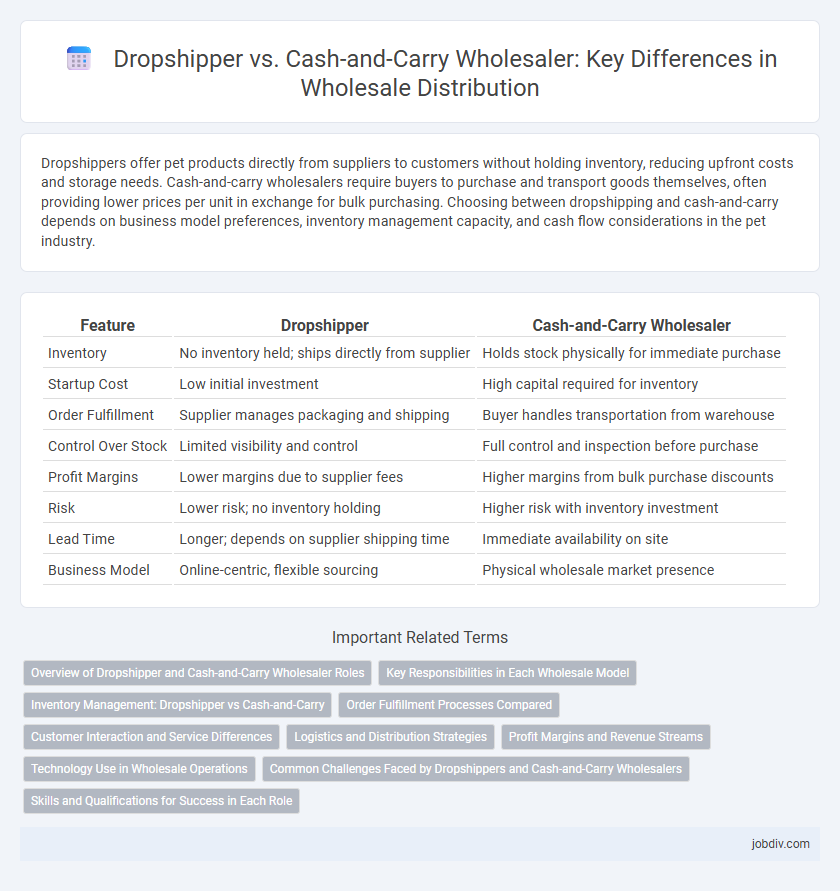Dropshippers offer pet products directly from suppliers to customers without holding inventory, reducing upfront costs and storage needs. Cash-and-carry wholesalers require buyers to purchase and transport goods themselves, often providing lower prices per unit in exchange for bulk purchasing. Choosing between dropshipping and cash-and-carry depends on business model preferences, inventory management capacity, and cash flow considerations in the pet industry.
Table of Comparison
| Feature | Dropshipper | Cash-and-Carry Wholesaler |
|---|---|---|
| Inventory | No inventory held; ships directly from supplier | Holds stock physically for immediate purchase |
| Startup Cost | Low initial investment | High capital required for inventory |
| Order Fulfillment | Supplier manages packaging and shipping | Buyer handles transportation from warehouse |
| Control Over Stock | Limited visibility and control | Full control and inspection before purchase |
| Profit Margins | Lower margins due to supplier fees | Higher margins from bulk purchase discounts |
| Risk | Lower risk; no inventory holding | Higher risk with inventory investment |
| Lead Time | Longer; depends on supplier shipping time | Immediate availability on site |
| Business Model | Online-centric, flexible sourcing | Physical wholesale market presence |
Overview of Dropshipper and Cash-and-Carry Wholesaler Roles
Dropshippers act as intermediaries who facilitate product sales without holding inventory, directly shipping goods from suppliers to customers, which reduces operational costs and inventory risks. Cash-and-carry wholesalers operate physical warehouses where buyers purchase products in bulk, paying upfront and handling transportation, offering immediate product availability and volume discounts. Both play distinct roles in the supply chain, with dropshippers emphasizing streamlined logistics and cash-and-carry wholesalers focusing on bulk transactions and inventory management.
Key Responsibilities in Each Wholesale Model
Dropshippers manage product listings, coordinate orders, and liaise directly with suppliers to fulfill customer purchases without holding inventory. Cash-and-carry wholesalers maintain large warehouses, stock products in bulk, and facilitate immediate customer pickup or delivery, emphasizing inventory management and logistical efficiency. Both models require strong supplier relationships and order accuracy, but dropshippers prioritize virtual coordination while cash-and-carry wholesalers focus on physical inventory control.
Inventory Management: Dropshipper vs Cash-and-Carry
Dropshippers operate without holding physical inventory, relying on suppliers to fulfill orders directly, which reduces overhead costs but limits control over stock availability and shipping times. Cash-and-carry wholesalers maintain substantial on-site inventory, enabling immediate product availability and faster delivery to retailers, though this requires higher warehousing expenses and inventory risk. Efficient inventory management in cash-and-carry models depends on accurate demand forecasting and stock replenishment strategies, while dropshippers must prioritize strong supplier relationships and real-time stock data integration.
Order Fulfillment Processes Compared
Dropshippers fulfill orders by directly shipping products from suppliers to customers, eliminating the need for inventory storage and allowing faster delivery times. Cash-and-carry wholesalers require buyers to purchase and transport goods themselves, involving physical inventory handling and immediate payment on pickup. The dropshipper model reduces warehousing costs, while cash-and-carry offers bulk purchasing advantages for retailers seeking control over stock.
Customer Interaction and Service Differences
Dropshippers typically minimize direct customer interaction by handling order fulfillment through third-party suppliers, enabling faster scalability and reduced inventory management. Cash-and-carry wholesalers engage customers face-to-face, offering immediate product access and personalized service, which builds trust and allows for on-the-spot transactions. The fundamental difference lies in dropshippers' reliance on digital communication and automation, while cash-and-carry wholesalers emphasize physical presence and direct customer support.
Logistics and Distribution Strategies
Dropshippers streamline logistics by directly shipping products from suppliers to customers, minimizing inventory holding and reducing storage costs. Cash-and-carry wholesalers maintain physical warehouses, enabling bulk purchasing and immediate product availability, which supports faster order fulfillment for local retailers. Distribution strategies for dropshippers emphasize digital integration and supplier coordination, whereas cash-and-carry models rely on efficient warehousing and transportation networks.
Profit Margins and Revenue Streams
Dropshippers benefit from lower overhead costs by eliminating inventory holding, allowing higher profit margins on a per-sale basis despite thinner revenue streams compared to cash-and-carry wholesalers. Cash-and-carry wholesalers generate consistent revenue through bulk sales with lower per-unit profit margins but enjoy faster turnover and immediate cash flow. Optimizing profit margins depends on balancing inventory costs, sales volume, and customer acquisition strategies unique to each wholesale model.
Technology Use in Wholesale Operations
Dropshippers leverage advanced e-commerce platforms, real-time inventory management systems, and automated order processing to efficiently fulfill customer orders without holding physical stock. Cash-and-carry wholesalers typically invest in warehouse management software and point-of-sale systems to streamline bulk inventory handling and instant customer transactions. Both models increasingly adopt cloud-based technologies to enhance supply chain visibility, reduce errors, and improve overall operational efficiency.
Common Challenges Faced by Dropshippers and Cash-and-Carry Wholesalers
Dropshippers often face challenges related to inventory management, shipping delays, and maintaining supplier relationships, impacting customer satisfaction and order fulfillment. Cash-and-carry wholesalers frequently encounter issues such as high overhead costs, inventory storage constraints, and fluctuating demand that affect their cash flow and operational efficiency. Both models struggle with market competition and maintaining competitive pricing while ensuring reliable product availability.
Skills and Qualifications for Success in Each Role
Dropshippers require strong digital marketing skills, proficient use of e-commerce platforms, and effective supplier communication to manage inventory virtually. Cash-and-carry wholesalers benefit from expertise in inventory management, logistics coordination, and customer relationship management to handle large-scale, in-person transactions efficiently. Both roles demand analytical abilities and adaptability, but dropshipping leans more towards technological proficiency, while cash-and-carry emphasizes operational and interpersonal skills.
Dropshipper vs Cash-and-Carry Wholesaler Infographic

 jobdiv.com
jobdiv.com